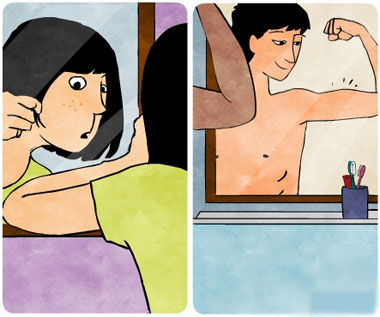Itsanobviousfactthatgirlswillingeneraldevelopquickerthanyoungmen,yetthisbiologicalcontrastforthemostpartisntobservableuntilaftertheageof10years.Intheeventthatyoutakeaganderatthedevelopmentgraphforbothyoungboysandyounggirls,theresasmooth,consistentinclineuntiltheyarriveat11to14years,whichiswhenmostchildrengetintothepubertalstage.Younggirlsstartandendadolescencesoonerthanyoungboys,andarriveattheirmostextremetallnesspotentialduringthattimespan,commonlyalongtimebeforesecondaryschoolgraduation.Itcanbringafewyoungboysintotheirschoolaverylongtimetoaccomplishtheirlastingstature.Younggirlscanenterpubertalimprovementasaheadofscheduleasage8,whileyoungboysmaybe9or10yearsofageintheeventthattheyreontheearlyend.InthisarticleWhatexactlyisPuberty?Whendoespubertystartandendingirls?Howdoesadolescenceandpubertyinfluencedevelopment?Whatpreventsordelayspuberty?NourishmentEmotionalchangeswhilegrowingupAtWhatAgeDoYouStopGrowing?Whatcausesdevelopmentdelays?Heightpredictionsandassumptionsforgirls.Whentoconsultadoctor?WhatexactlyisPuberty?Pubertyisthepointatwhichyourbodyexperiencesnumerouschanges—yourebecomingbothgenuinelyandsincerelyfromayoungsterintoanadolescentandintheendintoagrown-up.Despitethefactthatadolescencedoesntoccursimultaneouslyforeverybody,ittypicallybeginssomewhereintherangeof8and13yearsforyounggirls.Itisntsomethingthatoccursincidentally,yetaprocedurethattakesplaceoveraperiodoftime.Toenableyoutocomprehend,thisisthemeansbywhichyourbodyworks:Adolescenceisconstrainedbyhormones,whicharecommonsyntheticcompoundsmadeinyourbody.Thehormonesthataresignificantduringadolescenceinyounggirlsaremadeinthecerebrumandintheovaries.Yourovariesaretwolittleorgansthatlieoneithersideofyouruterus.Beginningatadolescence,yourovariesdischargeatleastonesmalleggseverymonth.Youruterusisalittleorganinyourlowermidsectionclosetoyourbladder.Atthepointwhenaladygetspregnant,thisistheplacetheinfantdevelops.Fallopiantubesaretube-formedstructuresthatleadfromtheovariestotheuterus.Theyconveytheeggsdischargedfromyourovariestoyouruterus.Thehormonesmadeintheovariesarecalledestrogenandprogesterone.Theyareanswerableforthemajorityoftheprogressionsthatwilloccurinyourbodyduringthistime.Changestoyourbodywillhappensteadily,overnumerousyears:Firstyourbreastswillbegintodevelop.Thisbeginswithonlyabitofexpandingundertheareola.Itwilltakequitealongwhiletoarriveatyourfullgrown-upbreastsize.Yourbodydevelopsmorebendsandyourhipsandthighsgetsomewhatmoreextensive.Itstypicalandsoundforyoutoputonweightwhileexperiencingpubescence.Youwillbegindevelopinghairunderyourarms,onyourlegsandinyourpubicterritory.Youwilllikewisedevelopintallness.This"developmentspray"happensrapidly.Byandlarge,younggirlsdeveloparound3inches(8cm)everyyearduringthedevelopmentspray.Younggirls,asarulequitdevelopingtalleraround2yearsinthewakeofbeginningtheirmenstrualperiod.Yourqualities(thecodeofdatayouacquiredfromyourfolks)willchoosenumerousthingsduringthistime,including:yourtallness,yourweight,thesizeofyourbreastsandevenhowmuchhairyouhaveonyourbody.Whendoespubertystartandendingirls?Younggirlswillingeneralexperienceadevelopmentspurtthattakesthemtotheirgrown-uptallnessintheirteenyears,astheyexperienceadolescence.Pubescenceistheprogressfromadolescencetoadulthood;itportraysaprogressionofchangesindividualsexperienceastheirbodiesbegintoexpandthecreationofspecifichormones.Inyounggirls,pubescencewillingeneralbeginbetweentheagesof10and14.Thenormalageforyounggirlstobeginpubescenceisaround11,howeveritisdistinctiveforeverybody.Forsomeadolescencecanbeginpriororlater,andthisistotallyordinary.Itwillingenerallastuntilanindividualisaround16.Inyounggirls,pubescencebeforetheageof8isatypical.Itisadditionallyviewedasatypicalifayounggirlhasnotdevelopedbreastsbythetimesheis13,orhasnotbegunherperiodsbytheageof16.Thesecircumstancesrequireclinicalconsiderationforadditionalassessment.Duringadolescence,younggirlswillencounteranincreasingspeedindevelopmentandwillstarttohaveperiods,knownasmenarche.Afewyounggirlsmayencounterextraordinarysexualconsiderationsandemotions.Theymaybegingettingzits,andthehairontheirlegsmaygetdarker.Thehormonesrelatedwithpubescencemaylikewisecauseyoungpeopletofeelpassionate,emotionalormoody.Oncemore,thisiscompletelytypical.Howdoesadolescenceandpubertyinfluencedevelopment?Younggirlsordinarilyhaveadevelopmentsprayintheonetotwoyearsbeforetheirmonthlycyclebegins.Formostyoungladies,pubescencehappenssomewhereintherangeof8and13yearsofageandthedevelopmentsprayhappenssomewhereintherangeof10and14yearsofage.Theygrowonly1to2extrainchesintheyearortwointhewakeofgettingtheirfirstperiod.Thisisthepointatwhichtheyarriveattheirgrown-uptallness.Mostyounggirlsarriveattheirgrown-upstaturebyage14or15.Thisagecouldbemoreyouthfulrelyinguponwhenayounggirlinitiallygetsherperiod.Youmightneedtocontactyouryoungstersprimarycarephysicianifyourlittlegirlis15andhasntyetstartedherperiod.Whatpreventsordelayspuberty?Aneveneatingroutineandawellbalanceddiet,whichgivesdevelopingyoungpeopleallthesupplementstheyneed,andkeepingphysicallyactivewillbolsterproceededwithdevelopmentandappropriateturnofevents.Inanycase,pubescenceandensuingdevelopmentcanbepostponedforanassortmentofreasons.Sacreddeferral,or"beingadelayedprodigy,"portraysanexampleoflateradvancementthatrunsinfamiliesandisnothingtostressover.Theseyoungsterswillcompletelygrow,onlylaterthantheircompanions.Younggirlsneedaspecificmeasureofmuscletofatratiobeforetheirbodiesbegintoexperienceadolescence.Thisimpliesyoungfemaleswhodoagreatdealofactivitymaystarttheprocedurelater.Youngsterswithlonghaulconditions,forexample,diabetes,cysticfibrosis,kidneyailment,orasthma,maylikewiseencounterdeferredadolescence.Thismightbemoreuncertainiftheconditionisallaroundcontrolled,withconstrainedconfusions.Issueswiththepituitaryorthyroidorgans,whichproducethehormonesthebodyneedstodevelopandcreate,canlikewisedeferpubescence.Inlikemanner,thechromosomeissuesrelatedwithsomehereditaryconditionscanmeddlewiththeprocedure.Beingoverweightcaninfluencehormonelevelsandsignthebeginningofpubescencesoonerthananticipated.NourishmentNourishmentissignificant,andsomebodywhoismalnourishedcangrowlaterthantheirfriends.Extremelackofhealthysustenanceasakidcanaddtodevelopmentdelays,whichcanhaveon-goingimpactsifnotadjusted.TheWHOportrayshindereddevelopmentinkidsdependentonanticipatedloadforstature,tallnessforageandweightforage.Kidsexperiencinghelplessnourishment,rehashedcontamination,anddeficientpsychosocialincitementarewellonthewaytohaveweakeneddevelopment.In2013,aspertheWorldHungerEducationService,morethan200millionyoungstersunderage5overallwerefundamentallymalnourishedorundernourishedleavingthemindangerfordeferredadolescence,justasotherformativeconfusions.EmotionalchangeswhilegrowingupInadditiontothefactthathormonescausephysicalchangesinyourbody,theycanlikewiseinfluencehowyoufeel.Feelingsduringadolescencemayfeelsomewhatlikeacrazyride.Youmay:Feartheadjustmentsinyourbodyonemomentandampedupforthemthefollowing.Feelconfusedandawkward.Laughonesecondandcrythefollowing.Getalongandbattlewitholdbuddiesallaroundthesametime.Feelangrynowandagain.Feelgrownuponedayandlikeayoungsterthefollowing.Nowandagain,theseprogressionscanbeoverpowering.Yourenottheonlyone.Likedifferentyoungsters,youreexperiencingatimeofprogressinyourlife.Ittendstobebothterrifyingandenergizingsimultaneously.Youjustneedtoacceptthesephysicalandemotionalchangesinyourlifeduringthistime.Itwillpassbeforeyouevenknowit.AtWhatAgeDoYouStopGrowing?Thetimingofpubescenceorpubertyassumesacriticaljobinaddressingthesubjectof"whendoyounggirlsstopdevelopinginheight?"Thatsbecausetheageatwhichayounggirlarrivesatgrown-upstaturereliesuponwhenshebeganherfirstperiod.Thestartingindicationsoffemalepubescence,includingbreastdevelopment,bodyhairdevelopment,andrelease,areindicationsthatyourlittlegirlmaysoonstarttodevelopinstaturequickerthanshehaspreviously.Younggirlswhoareexperiencingadolescencenormallyexperienceadevelopmentspurtaftertheirbreastsstarttodevelop,trailedbytheirfirstperiodafewyearsafterthefact.Younggirlsquitbecomingtallerandarriveattheirlastgrown-uptallnessonlytwototwo-and-halfyearsafterthatfirstmenstrualcycle.Whatcausesdevelopmentdelays?Therearenumerouselementsthatinfluencedevelopment,extendingfromlackofhealthysustenancetomedications.Afewyounggirlsmayseeadeferralindevelopmentbecauseofcertainwellbeingconditions,forexample,developmenthormoneissues,extremejointinflammation/arthritis,orcancer.Hereditaryconditionsassumeajobtoo.Forinstance,younggirlswithDownsyndrome,Noonandisorder,orTurnerdisordermightbeshorterthantheirfamilymembers.YounggirlswithMarfansdisordermaybecometallerthantheirrelatives.Ontheoffchancethatyouhaveworriesaboutyourkidsdevelopment,contacttheirpediatrician.Whenayounggirlarrivesatpubescence,developmentwillcommonlystoptwoorthreeyearsafterherfirstperiod.Ateenagerwhohasdeferreddevelopmentwillhavelessanidealopportunitytodevelopbeforethefinishofherspurt.Heightpredictionsandassumptionsforgirls.Whiletheresnoexactmethodtopreciselydecidehowtallindividualswillbeoncetheybegindeveloping,therearetwobasicstrategiespediatriciansusetoanticipategrown-upstatureforyounggirls.Mostspecialistsutilizewhatsknownasa"mid-parentalheightcalculator"toforeseegrown-uptallness,somestudiessaythismethodis"stillexceptionallyoffbase."Forthiscomputation,youtaketheyounggirlsdadsstatureanddeduct5inches,thenaddthatnumbertotheyounggirlsmomstallnessanddividethesumby2.Thesubsequentnumber,giveortake3.35inches,istheanticipatedscopeoftallnesstheyounggirlshouldreach."Forinstance,iffatheris510"andmotheris55",youwouldtake510"less5inches,thatis55",addittomotherstallnessandaveragethetwo,whichis55"—thatisaforecastthattheirgirloughttodeveloptobe55",plusorminusaround3inches"UtilizingtheCentersforDiseaseControl(CDC)girlsdevelopmentchart,forinstance,a10-year-oldyounggirlwhostands54inchestall(46")isinthe50thpercentileforherage.Followingthatdevelopmentbendout,sheshouldarriveatastaturesimplyover54"nolaterthanage18.Whentoconsultadoctor?Intheeventthatyourgirlappearstobealongwaypastorbehindhercompanionsinphysicalturnofevents,itmightbeanidealopportunitytoconversewithherpediatrician.Younggirlswhodontgiveindicationsofbreastdevelopmentbytheageof13aswellasdonthavetheirfirstmenstruationcyclebytheageof15or16areviewedaspostponedinadolescence.Ontheotherside,ayounggirlwhosgivingindicationsofadolescenceat6or7yearsofageisencounteringearlypubescence.Withbothofthoseboundaries,haveherpediatricianinvestigateinlightofthefactthattherecouldbeclinicalorendocrine(hormonal)issuescausingearlyorpostponedadolescence.PediatricianscandoaboneageX-raytodecidewhetheryourgirlisontargettoarriveatnormalgrown-upstature.Whendogirlsstartgrowingphysicallyandemotionally?Whendogirlsstopgrowing?Whatchangesdoesyourbodygothroughduringpuberty?Shouldyoubeworriedifyourchild’sgrowthisslowerthanotherkids?Howtopredictyourchild’sheight?Discusshere.
Its an obvious fact that girls will in general develop quicker than young men, yet this biological contrast for the most part isn't observable until after the age of 10 years.In the event that you take a gander at the development graph for both young boys and young girls, there's a smooth, consistent incline until they arrive at 11 to 14 years, which is when most children get into the pubertal stage.
Young girls start and end adolescence sooner than young boys, and arrive at their most extreme tallness potential during that time span, commonly a long time before secondary school graduation. It can bring a few young boys into their school a very long time to accomplish their lasting stature. Young girls can enter pubertal improvement as ahead of schedule as age 8, while young boys may be 9 or 10 years of age in the event that they're on the early end.
What exactly is Puberty?
Puberty is the point at which your body experiences numerous changes—you're becoming both genuinely and sincerely from a youngster into an adolescent and in the end into a grown-up.
Despite the fact that adolescence doesn't occur simultaneously for everybody, it typically begins somewhere in the range of 8 and 13 years for young girls. It isn't something that occurs incidentally, yet a procedure that takes place over a period of time.
To enable you to comprehend, this is the means by which your body works:
Adolescence is constrained by hormones, which are common synthetic compounds made in your body. The hormones that are significant during adolescence in young girls are made in the cerebrum and in the ovaries.
Your ovaries are two little organs that lie on either side of your uterus. Beginning at adolescence, your ovaries discharge at least one small eggs every month.
Your uterus is a little organ in your lower midsection close to your bladder. At the point when a lady gets pregnant, this is the place the infant develops.
Fallopian tubes are tube-formed structures that lead from the ovaries to the uterus. They convey the eggs discharged from your ovaries to your uterus.
The hormones made in the ovaries are called estrogen and progesterone. They are answerable for the majority of the progressions that will occur in your body during this time.
Changes to your body will happen steadily, over numerous years:
First your breasts will begin to develop. This begins with only a bit of expanding under the areola. It will take quite a long while to arrive at your full grown-up breast size.
Your body develops more bends and your hips and thighs get somewhat more extensive. It's typical and sound for you to put on weight while experiencing pubescence.
You will begin developing hair under your arms, on your legs and in your pubic territory.
You will likewise develop in tallness. This "development spray" happens rapidly. By and large, young girls develop around 3 inches (8 cm) every year during the development spray. Young girls, as a rule quit developing taller around 2 years in the wake of beginning their menstrual period.
Your qualities (the code of data you acquired from your folks) will choose numerous things during this time, including: your tallness, your weight, the size of your breasts and even how much hair you have on your body.
When does puberty start and end in girls?
Young girls will in general experience a development spurt that takes them to their grown-up tallness in their teen years, as they experience adolescence.
Pubescence is the progress from adolescence to adulthood; it portrays a progression of changes individuals experience as their bodies begin to expand the creation of specific hormones.
In young girls, pubescence will in general begin between the ages of 10 and 14. The normal age for young girls to begin pubescence is around 11, however it is distinctive for everybody.
For some adolescence can begin prior or later, and this is totally ordinary. It will in general last until an individual is around 16.
In young girls, pubescence before the age of 8 is atypical. It is additionally viewed as atypical if a young girl has not developed breasts by the time she is 13, or has not begun her periods by the age of 16. These circumstances require clinical consideration for additional assessment.
During adolescence, young girls will encounter an increasing speed in development and will start to have periods, known as menarche. A few young girls may encounter extraordinary sexual considerations and emotions. They may begin getting zits, and the hair on their legs may get darker.
The hormones related with pubescence may likewise cause young people to feel passionate, emotional or moody. Once more, this is completely typical.
How does adolescence and puberty influence development?
Young girls ordinarily have a development spray in the one to two years before their monthly cycle begins.
For most young ladies, pubescence happens somewhere in the range of 8 and 13 years of age and the development spray happens somewhere in the range of 10 and 14 years of age. They grow only 1 to 2 extra inches in the year or two in the wake of getting their first period. This is the point at which they arrive at their grown-up tallness.
Most young girls arrive at their grown-up stature by age 14 or 15. This age could be more youthful relying upon when a young girl initially gets her period.
You might need to contact your youngster's primary care physician if your little girl is 15 and hasn't yet started her period.
What prevents or delays puberty?
An even eating routine and a well balanced diet, which gives developing young people all the supplements they need, and keeping physically active will bolster proceeded with development and appropriate turn of events.
In any case, pubescence and ensuing development can be postponed for an assortment of reasons. Sacred deferral, or "being a delayed prodigy," portrays an example of later advancement that runs in families and is nothing to stress over. These youngsters will completely grow, only later than their companions.
Young girls need a specific measure of muscle to fat ratio before their bodies begin to experience adolescence. This implies young females who do a great deal of activity may start the procedure later.
Youngsters with long haul conditions, for example, diabetes, cystic fibrosis, kidney ailment, or asthma, may likewise encounter deferred adolescence. This might be more uncertain if the condition is all around controlled, with constrained confusions.
Issues with the pituitary or thyroid organs, which produce the hormones the body needs to develop and create, can likewise defer pubescence. In like manner, the chromosome issues related with some hereditary conditions can meddle with the procedure.
Being overweight can influence hormone levels and sign the beginning of pubescence sooner than anticipated.
Nourishment
Nourishment is significant, and somebody who is malnourished can grow later than their friends. Extreme lack of healthy sustenance as a kid can add to development delays, which can have on-going impacts if not adjusted.
The WHO portrays hindered development in kids dependent on anticipated load for stature, tallness for age and weight for age. Kids experiencing helpless nourishment, rehashed contamination, and deficient psychosocial incitement are well on the way to have weakened development.
In 2013, as per the World Hunger Education Service, more than 200 million youngsters under age 5 overall were fundamentally malnourished or undernourished leaving them in danger for deferred adolescence, just as other formative confusions.
Emotional changes while growing up
In addition to the fact that hormones cause physical changes in your body, they can likewise influence how you feel. Feelings during adolescence may feel somewhat like a crazy ride. You may:
Fear the adjustments in your body one moment and amped up for them the following.
- Feel confused and awkward.
- Laugh one second and cry the following.
- Get along and battle with old buddies all around the same time.
- Feel angry now and again.
- Feel grown up one day and like a youngster the following.
Now and again, these progressions can be overpowering. You're not the only one. Like different youngsters, you're experiencing a time of progress in your life. It tends to be both terrifying and energizing simultaneously. You just need to accept these physical and emotional changes in your life during this time. It will pass before you even know it.
At What Age Do You Stop Growing?
The timing of pubescence or puberty assumes a critical job in addressing the subject of "when do young girls stop developing in height?" That's because the age at which a young girl arrives at grown-up stature relies upon when she began her first period.
The starting indications of female pubescence, including breast development, body hair development, and release, are indications that your little girl may soon start to develop in stature quicker than she has previously. Young girls who are experiencing adolescence normally experience a development spurt after their breasts start to develop, trailed by their first period a few years after the fact. Young girls quit becoming taller and arrive at their last grown-up tallness only two to two-and-half years after that first menstrual cycle.
What causes development delays?
There are numerous elements that influence development, extending from lack of healthy sustenance to medications. A few young girls may see a deferral in development because of certain wellbeing conditions, for example, development hormone issues, extreme joint inflammation/arthritis, or cancer. Hereditary conditions assume a job too. For instance, young girls with Down syndrome, Noonan disorder, or Turner disorder might be shorter than their family members. Young girls with Marfan's disorder may become taller than their relatives.
On the off chance that you have worries about your kid's development, contact their pediatrician. When a young girl arrives at pubescence, development will commonly stop two or three years after her first period. A teenager who has deferred development will have less an ideal opportunity to develop before the finish of her spurt.
Height predictions and assumptions for girls.
While there's no exact method to precisely decide how tall individuals will be once they begin developing, there are two basic strategies pediatricians use to anticipate grown-up stature for young girls.
Most specialists utilize what's known as a "mid-parental height calculator" to foresee grown-up tallness, some studies say this method is "still exceptionally off base." For this computation, you take the young girl's dad's stature and deduct 5 inches, then add that number to the young girl's mom's tallness and divide the sum by 2. The subsequent number, give or take 3.35 inches, is the anticipated scope of tallness the young girl should reach.
"For instance, if father is 5'10" and mother is 5'5", you would take 5'10" less 5 inches, that is 5'5", add it to mother's tallness and average the two, which is 5'5"— that is a forecast that their girl ought to develop to be 5'5", plus or minus around 3 inches"
Utilizing the Centers for Disease Control (CDC) girls development chart, for instance, a 10-year-old young girl who stands 54 inches tall (4'6") is in the 50th percentile for her age. Following that development bend out, she should arrive at a stature simply over 5'4" no later than age 18.
When to consult a doctor?
In the event that your girl appears to be a long way past or behind her companions in physical turn of events, it might be an ideal opportunity to converse with her pediatrician. Young girls who don't give indications of breast development by the age of 13 as well as don't have their first menstruation cycle by the age of 15 or 16 are viewed as postponed in adolescence. On the other side, a young girl who's giving indications of adolescence at 6 or 7 years of age is encountering early pubescence. With both of those boundaries, have her pediatrician investigate in light of the fact that there could be clinical or endocrine (hormonal) issues causing early or postponed adolescence. Pediatricians can do a bone age X-ray to decide whether your girl is on target to arrive at normal grown-up stature.
When do girls start growing physically and emotionally? When do girls stop growing? What changes does your body go through during puberty? Should you be worried if your child’s growth is slower than other kids? How to predict your child’s height? Discuss here.






























